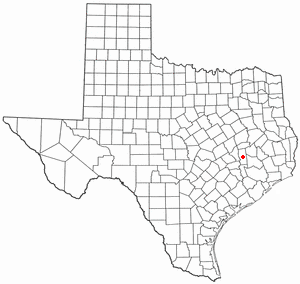
Anderson is a city and county seat of Grimes County, Texas, United States. The population was 193 as of the 2020 census. The town and its surroundings are listed on the National Register of Historic Places as the Anderson Historic District.

Starr Family Home State Historic Site is a 3.1-acre (1.3 ha) historical site operated by the Texas Historical Commission in downtown Marshall, Texas. It was listed on the National Register of Historic Places in 1979. The museum was made a Recorded Texas Historic Landmark in 1986. On January 1, 2008, the site was transferred from the Texas Parks and Wildlife Department to the Texas Historical Commission.

Ginocchio Historic District, in Marshall, Texas is a historic district listed on the National Register of Historic Places. The district takes its name from the Ginocchio family who operated a hotel, The Ginocchio, in the district during the late 19th and early 20th centuries. The district houses numerous historic buildings including: Allen House, The Ginocchio, T&P Depot, the Heflin-Thompson House and the Whaley House. The district is also home to two museums the Harrison County Historical Museum in the Ginocchio and the T&P Railway Museum in the T&P Depot. On January 26, 2007, the Heflin-Thompson House caught fire and suffered much damage. Ricky Thompson, Joel and Michelle Heflin all lost their home and most of their belongings in the fire.

The Medina Dam is a hollow-masonry type dam built in 1911 and 1912 by the Medina Irrigation Company in what became Mico, Texas, USA. Medina Lake extends north of it in northeastern Medina County and southeastern Bandera County. The dam and irrigation project was designed and financed by Dr. Frederick Stark Pearson, an American engineer, with extensive British financial backing. The construction took over 1500 men two years to build while working 24 hours a day. They were mostly skilled Mexican workers with experience building other dams for Pearson. They received two dollars for a day's work, which were good wages for the time. Pearson's Medina Irrigation Company (MICO) built a camp to house the workers and their families; the company town was first called MICO after its acronym. The community is now known as Mico, Texas.
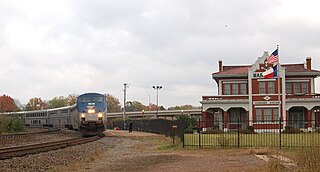
Marshall station is a railroad station in Marshall, Texas. It is served by Amtrak, the national railroad passenger system, which operates the Texas Eagle through Marshall each day, with service north to Chicago and west-southwest to Dallas, San Antonio and Los Angeles. The station also houses the Texas and Pacific Railway Depot & Museum.
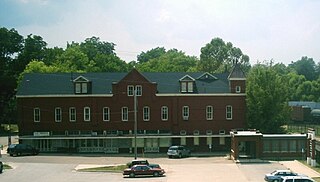
The Ginocchio or Ginocchio Hotel is a historic hotel in Marshall, Texas that was originally constructed in 1896 next to the Texas and Pacific Railway station. At that time, it was on the same side of the tracks and provided disembarking passengers with ready access to a hotel and restaurant facility. During its height, the building housed several U.S. Presidents and actor John Barrymore, among others. The name is derived from the family that built the building and is located in the Ginocchio Historic District of the National Register of Historic Places. In 2017, the establishment reopened under new ownership as a restaurant and bar after being closed for renovations for two years.

The Swiss Avenue Historic District is a residential neighborhood in East Dallas, Dallas, Texas (USA). It consists of installations of the Munger Place addition, one of East Dallas' early subdivisions. The Swiss Avenue Historic District is a historic district of the city of Dallas, Texas. The boundaries of the district comprise both sides of Swiss Avenue from Fitzhugh Street, to just north of La Vista, and includes portions of Bryan Parkway. The District includes the 6100-6200 blocks of La Vista Drive, the west side of the 5500 block of Bryan Parkway the 6100-6300 blocks of Bryan Parkway, the east side of the 5200-5300 block of Live Oak Street, and the 4900-6100 blocks of Swiss Avenue. The entire street of Swiss Avenue is not included within the bounds of the Swiss Avenue Historic District. Portions of the street run through Dallas' Peaks Suburban Addition neighborhood and Peak's Suburban Addition Historic District. 5215 Swiss was built in 1914 and was the home of J. P. Cranfield

The M. A. Benton House is an historic landmark in Fort Worth, Texas (USA), located on a four-lot corner at 1730 Sixth Avenue. This Victorian-style house, still owned by Benton descendants, was built in 1898 and is one of the oldest homes in Fort Worth. The descendants have preserved the cottage's architecture features, including the one-and-a-half-story structure and the fence that has surrounded the cottage since it was first built. As a family home, it is not open to the public. The Benton House is individually listed on the National Register of Historic Places for its architectural qualities. In 1971, the Benton House was designated a Recorded Texas Historic Landmark.

The Bandera County Courthouse and Jail are two separate historic county governmental buildings located near each other in Bandera, Bandera County, Texas, The Bandera County Courthouse, built in 1890 at the corner of Main and Pecan streets, is a Renaissance Revival style building designed by San Antonio architect B. F. Trester. It is three-story building with a central clock tower made from rusticated limestone cut from a local quarry. The clock is non-functioning and painted on, displaying the time 10:09. The current jail is a non-historic, modern facility located along State Highway 16 on the north end of town.

The architectural structures of Fredericksburg, Texas are often unique to the Texas Hill Country, and are historical edifices of the German immigrants who settled the area in the 19th Century. Many of the structures have historic designations on a state or national level. The Gillespie County Historical Society is actively involved in assisting with preservation.

The Llano County Courthouse and Jail were erected separately, but added to the National Register of Historic Places in Texas on December 2, 1977 as one entry. The courthouse, located in the middle of Llano's historic square, was built in 1893. The exterior is made of sandstone, marble, and granite. The interior of the courthouse was damaged by fire in 1932 and again in 1951. It is still in use today by local government. The jail was erected in 1895, with the prisoner cells on the second and third floors, and the ground level solely for the office and living accommodations for the sheriff and his family. The jail was designated a Recorded Texas Historic Landmark 1979, Marker 9448. The courthouse was designated a Recorded Texas Historic Landmark 1980, Marker number 9446.

The Milam County Courthouse and Jail are two separate historic county governmental buildings located diagonally opposite each other in Cameron, Milam County, Texas. The Milam County Courthouse, located at 100 South Fannin Avenue, was built in 1890–1892, while the Milam County Jail, now known as the Milam County Museum, was built in 1895. On December 20, 1977, they were added to the National Register of Historic Places as a single entry.

The Barker House or David Barker House is a historic house located in Houston, Texas It was listed on the National Register of Historic Places on 14 May 1984 and designated a Recorded Texas Historic Landmark in 1990.

The William J. Bryce House, known as Fairview, is located on 4900 Bryce Avenue in Fort Worth, in the U.S. state of Texas.

The Arnot House is a raised one-story house located at 306 W. Houston Street in Marshall, Texas. Built in 1848, it is one of the oldest houses in Marshall. An early Greek Revival style building, it is also described as a "classic Creole, or Louisiana raised-cottage, rendered in the Greek Revival style." It is made of wood frame on load-bearing brick basement/ground floor walls, with "Marshall Brown" brick laid in common bond. The front porch, which is covered by the house's gable roof, "is articulated with stout square columns, placing the house in the early phase of Greek Revival."

The Fry-Barry House is a one-story, brick and frame house located at 314 W. Austin in Marshall, Texas. Built in 1860 the house is one of the oldest homes in Marshall. It was designed by W.R.D. Ward, a planter and merchant who also designed Magnolia Hall. Major Edwin James Fry, a businessman and banker, purchased the house in 1872. When Fry died in 1927, his daughter, Pamela and her husband, Walter L. Barry inherited the house. Mary Louise Barry inherited the house in 1961.
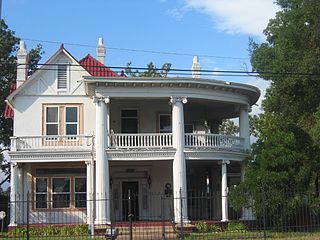
The Hochwald House is a Victorian 2+1⁄2-story house on 211 West Grand Avenue in Marshall, Texas. Built 1894 to 1895, the house was named after Isaac Hochwald (1865-1956), a prominent Jewish merchant. In 1912, the house was renovated to include classical revival features. Hochwald, who built the house with his wife Amelia Raphel Hochwald, lived in the house until 1956.
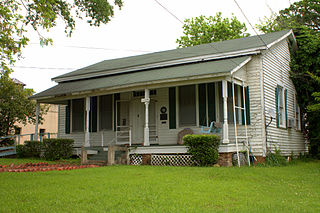
The James Turner House, a one-story Greek Revival style building located on 406 North Washington Avenue in Marshall, Texas, was built by a merchant, George Gammon Gregg to be the home for him and his bride, Mary Ann Wilson, who were married in 1851. It was first located at the southeast corner of Crockett Street and Washington Avenue.

The Simon and Mamie Minchen House is a single-family residence in the Ormond Place subdivision in Boulevard Oaks, Houston. It is listed on the National Register of Historic Places, #00001496, as of December 7, 2000. It is also a Recorded Texas Historic Landmark and a Protected Houston Landmark. The two-story house uses an Italian Renaissance architectural style, and it also has a garage of the same height, which can hold three cars. The property also has a residence formerly used for servants.






















